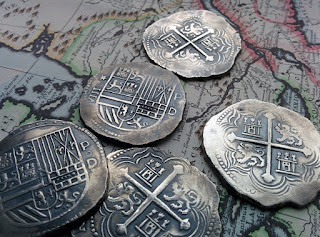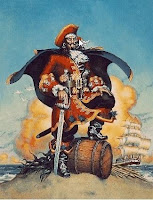Pieces of Eight
Did you know that the Spanish dollar was used by many countries as the first international currency because of its uniformity? Even the United States used it as its first form of currency until the Coinage Act of 1957. In the book, "Under the Black Flag," were from the New World around the late 1500s. This was happening around the time called the great pirate era when pirates were hauling off large amounts of treasure.
David Cordingly explains that "the Spanish dollar was called the "Pieces of Eight" and were produced from Spain. They usually had the Spanish coat of arms on one side and a design representing the pillars of Hercules on the other. The twin pillars symbolized the limits of the ancient world at the Strait of Gibraltar, and the early designs they were depicted rising out of the sea"(Cordingly 36). The Pieces of Eight, also known as pesos, were the most famous treasures from the New World. They were some of the many pillages of pirates from the New World. The New World had numerous ports full of treasure during that time.
In the late 16th century, Sir Francis Drake, an Englishman that chose the life of piracy, raided a mule train in Central America taking much silver and gold. While sailing the New World, he captured a Spanish ship called the Cacafuego that carried 12 million pounds in treasure. Another haul was by Jean Fleury of France. He was voyaging off Portugal when he captured two Spanish ships full of Aztec treasure, this alerted all of Europe to the wealth found in the New World.
During the Golden Age of Piracy, Cordingly explains that "Nombre De Dios lies in the corner of the bay on the Isthmus of Panama . In the 1570s, it was one of the principal treasure ports on the Spanish Main, that hot and humid stretch of the American coast which curves around the southern rim of the Caribbean Sea"(Cordingly 26). Spanish fleets bayed there and loaded up with gold and silver.
David Cordingly explains that "the Spanish dollar was called the "Pieces of Eight" and were produced from Spain. They usually had the Spanish coat of arms on one side and a design representing the pillars of Hercules on the other. The twin pillars symbolized the limits of the ancient world at the Strait of Gibraltar, and the early designs they were depicted rising out of the sea"(Cordingly 36). The Pieces of Eight, also known as pesos, were the most famous treasures from the New World. They were some of the many pillages of pirates from the New World. The New World had numerous ports full of treasure during that time.
In the late 16th century, Sir Francis Drake, an Englishman that chose the life of piracy, raided a mule train in Central America taking much silver and gold. While sailing the New World, he captured a Spanish ship called the Cacafuego that carried 12 million pounds in treasure. Another haul was by Jean Fleury of France. He was voyaging off Portugal when he captured two Spanish ships full of Aztec treasure, this alerted all of Europe to the wealth found in the New World.
During the Golden Age of Piracy, Cordingly explains that "Nombre De Dios lies in the corner of the bay on the Isthmus of Panama . In the 1570s, it was one of the principal treasure ports on the Spanish Main, that hot and humid stretch of the American coast which curves around the southern rim of the Caribbean Sea"(Cordingly 26). Spanish fleets bayed there and loaded up with gold and silver.




Comments
Post a Comment